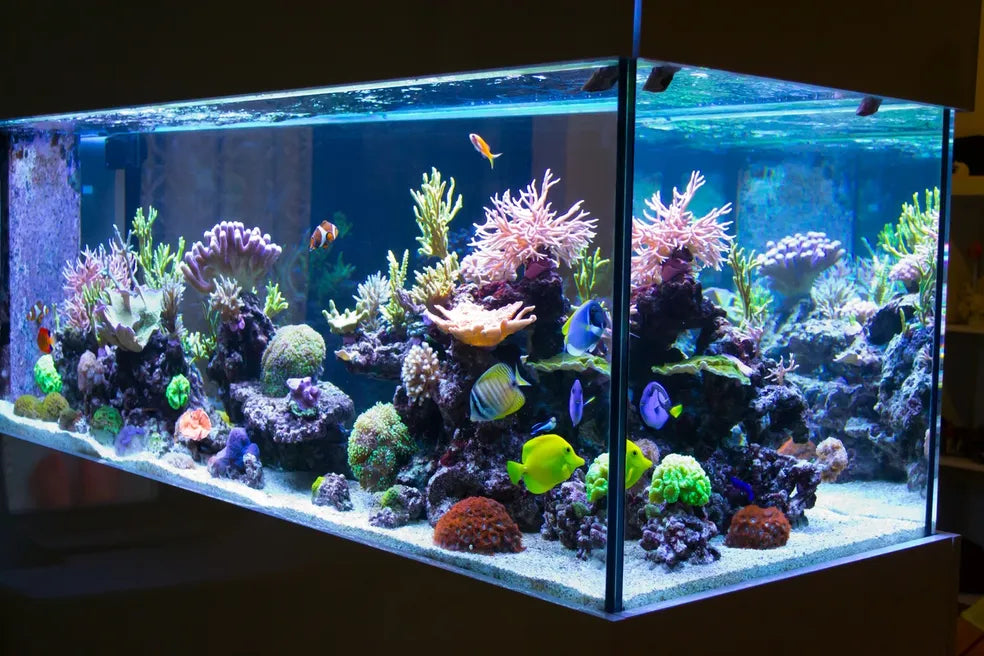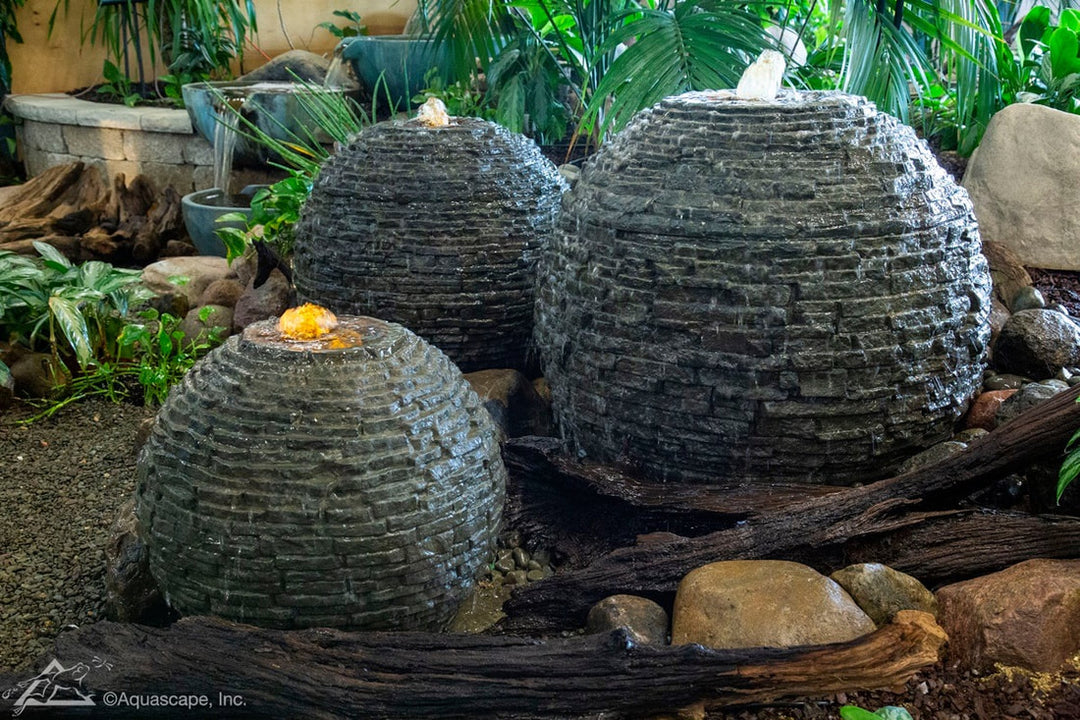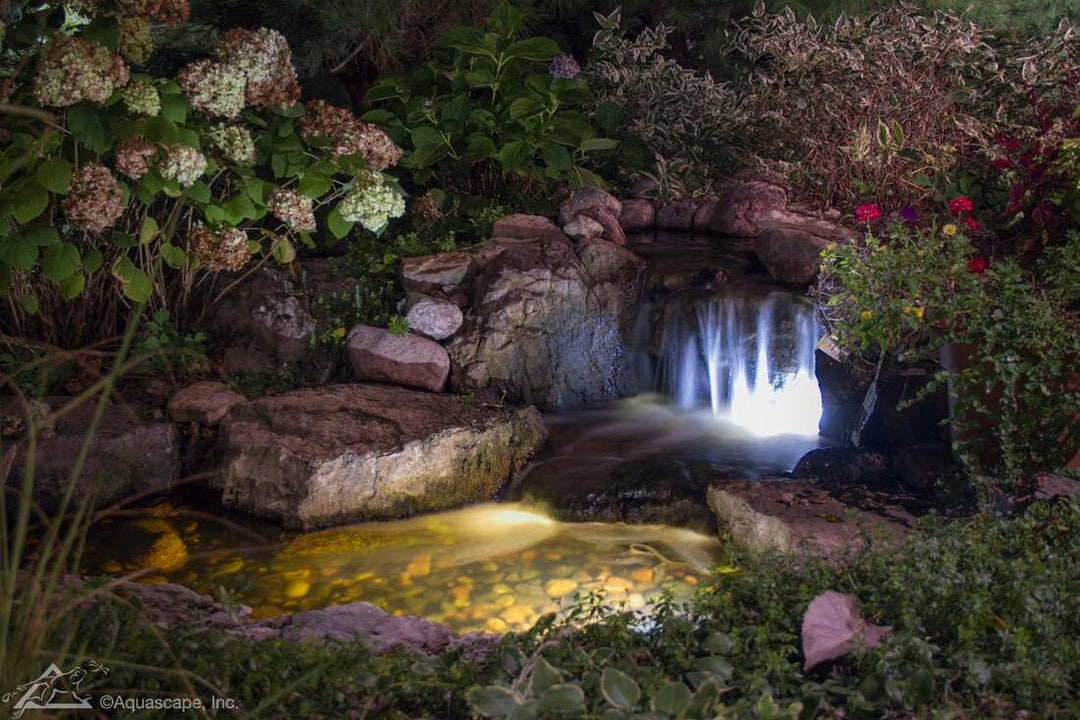
MarinePure High Performance Ceramic Biofilter Media - PODs 3 Count
MP700603
- In stock, ready to ship
- Inventory on the way
MarinePure is designed to be a substrate for bio-filtration, specifically to target ammonia and nitrite removal (nitrification) and to minimize nitrates (denitrification). MarinePure is suitable for both freshwater and saltwater (marine) environments. MarinePure can be used fully submerged or in trickle/shower filters. It should not be used in moving bed filters.
PODs
The MarinePure PODs are about 3.1 inches in diameter, created with grooves to produce a randomized water current in and around the part, ensuring greater water and media contact. Just one Pod has the equivalent surface area of over 5,000 plastic bio-balls!
Our MarinePure POD has a unique, appealing design that helps increase its durability, with a deep cross section to help you achieve more nitrate control, making it the perfect media filter for aquariums, ponds, and aquaculture.
3 count good for 100 gallons
24 count good for 750 gallons
MarinePure
MarinePure is the perfect place for beneficial bacteria to flourish in order to remove harmful fish wastes. It will eliminate ammonia and lower nitrates.
MarinePure's bio-media is the most technically advanced bio-media available today.
Features Thin Bio-Film Technology
MarinePure is inert and will not harm aquarium inhabitants.
Why Use MarinePure
- Better value due to high performance
- Reduced tank maintenance
- Allows for higher fish loads
- Can use a smaller filtration footprint
- More consistent water chemistry
- Easy to shape
Can be used in a variety of applications;
- Used in tank
- Used in sumps
- Used in canister filters
- Used in DIY filters
- Used in trickle or shower filters
- Used in waterfall filters
- Used in hang on back filters
Thin Bio-Film Technology
Combination of vast surface area and open/interconnected pores allow a thin bio-film to develop.
This thin film allows bacteria to flourish because necessary nutrients are immediately available.
With the open pores, old dead bio-film is easily flushed from the media and will not plug the media.
Water flows through the media, not around as with other denser medias, thus utilizing the most surface area for beneficial bacterial growth.
SIZES
1" Spheres
Designed for Ammonia and Nitrite Removal
One MarinePure Sphere has the same surface area as 1,350 plastic 1.5" bio-balls.
Use in canister filters, sumps, and wet/dry filters.
8x8x4" Block
Ammonia, Nitrite and Nitrate Removal
Primarily designed to provide deep anaerobic zones for de-nitrification in passive systems.
Live rock substitute-popular among reef hobbyists as a substitute for live rock because it reduces nitrates more efficiently without harming the environment.
Use in sumps, stacked in extra-large filters.
MarinePure Technical Info
MarinePure is designed to be a substrate for bio-filtration, specifically to target ammonia and nitrite removal (nitrification) and to minimize nitrates (denitrification). MarinePure is suitable for both freshwater and saltwater (marine) environments. MarinePure can be used fully submerged or in trickle/shower filters. It should not be used in moving bed filters.
- Light Weight Bulk Density = 0.3 - 0.5 g/cc
- High Surface Area 1.3 - 1.7 m2/g
- Open Pore Structure 80 - 90% Open Porosity
- Chemically Inert
- Hydrophilic Adsorbs water and stays wet longer
- Low Pressure Drop
- Unaffected by ozone
Usage Recommendations
Nitrification
Recommended MarinePure amount for to eliminate ammonia and nitrite in an active filter, for a typical bio-load.
|
Recommended Minimum MarinePure Amounts |
||||||
|
Tank Size |
GEMS |
Spheres |
Plates |
Blocks* |
MP2C (for pond filters) |
MP2C-c (for pond filters) |
|
50 gal. |
1 box |
< 1 quart |
< 1 plate |
< 1 block |
n/a |
< 1 gallon |
|
100 gal. |
n/a |
1 quart |
1 plate |
< 1 block |
n/a |
< 1 gallon |
|
250 gal. |
n/a |
2 quarts |
2 plates |
1 block |
ft3 |
< 1 gallon |
|
500 gal. |
n/a |
1-2 gallons |
3-4 plates |
1-2 blocks |
- 1 ft3 |
1 gallon |
|
2,500 gal. |
n/a |
3-4 gallons |
12 plates |
4 blocks |
2 ft3 |
2 gallons |
|
10,000 gal. |
n/a |
n/a |
n/a |
n/a |
8 ft3 |
n/a |
* MarinePure's thick blocks are designed to be used in passive systems to control nitrates. If used in active systems they will eliminate ammonia and nitrites (nitrification).
Denitrification
Recommended MarinePure amount to minimize nitrates in a passive filter, for a typical bio-load.
|
Recommended Minimum MarinePure Amounts |
|
|
Tank Size |
Blocks in passive location |
|
50 gal. |
1 block |
|
100 gal. |
1 block |
|
250 gal. |
2 blocks |
|
500 gal. |
3 blocks |
|
2,500 gal. |
15 blocks |
|
10,000 gal. |
60 blocks |
* MarinePure's thick blocks are designed to be used in passive systems to control Nitrates (like live rock). If used in active systems they will eliminate ammonia and nitrites (nitrification).
MarinePure Instructions
MarinePure is designed to be a substrate for bio-filtration, specifically to target ammonia and nitrite removal and to minimize nitrates.
MarinePure is suitable for both freshwater and saltwater environments. MarinePure can be used fully submerged or in trickle/shower filters.
For removal of Ammonia and Nitrites (Nitrification)
- Initial rinse of media with water to remove surface particulate created during shipping.
If tap water is used, perform second rinse with tank water to remove chlorine. - Locate media in filter, sump, under gravel bed, anywhere in the tank or as part of a reef structure. Locating within the flow of the water will give the most efficient results.
- NOTE: the product is easily shaped using a hand saw or coarse sand paper. Make sure to rinse particulate before placing in tank.
Wear a a dust mask to avoid breathing in particulate - Mechanical filtration of water, such as with matting, is recommended prior to water entering MarinePure product
Maintenance for flow-through filter systems
- Periodic backwashing or rinsing using tank water suggested every 3 months or as frequently as necessary.
For removal of Nitrates (Denitrification)
- Initial rinse of media with water to remove surface particulate created during shipping.
If tap water is used, perform second rinse with tank water to remove chlorine. - Locate media in a passive location such as in a sump, under gravel bed, or as part of a reef structure.
- NOTE: If desired, the product can be easily shaped using a hand saw or coarse sand paper. Make sure to rinse off particulate before placing in tank.
- Wear a a dust mask to avoid breathing in particulate
Maintenance for passive filter systems
If necessary, backwash and / or rinse as described above.
- Although product should be self-cleaning, applications and use vary.
- A weak acid can be used for cleaning, but time in acid conditions should be minimized. Make sure to wear appropriate Personal Protective Equipment when using acid.
MarinePure FAQs
What makes MarinePure bio-media unique?
Its unique combination of large open pores and high surface area. This allows a large amount of bacteria easy access to nutrients (ammonia, nitrite and nitrate) and old bio-film to be easily flushed from the system.
Why is a bio-filter important?
Ammonia and nitrite are very harmful to fish and must be eliminated. A properly operating bio-filter will result in imperceptible levels of both.
What is Thin Bio-Film Technology and what does it mean to me?
The open porosity and vast surface area of MarinePure means healthier bacteria colonies and less clogging.
What is the Nitrogen cycle and why is it important?
The most important thing to understand about keeping fish is that it is the bacteria of the nitrogen cycle that make an aquarium tank healthy.
The nitrogen cycle begins when fish are added to the tank. The fish consume protein in their food and excrete ammonia (NH4) in their waste. Ammonia is extremely toxic to fish and will kill them if not eliminated from the tank. There is a bacteria species (Nitrosomonas) that will grow if it can find a suitable home. This bacteria will convert the Ammonia into Nitrite (NO2). Nitrite, while not as toxic as ammonia, is still harmful to your fish. Another species of bacteria (Nitrospira) will convert Nitrite into Nitrate (NO3). Nitrate is not harmful in small amounts and can be reduced in three ways.
By changing out a portion of the tank water each week.
By adding more plants to consume nitrates.
By creating an anoxic environment where special bacteria can thrive and consume nitrates.
The nitrogen cycle is completed when the nitrates are converted into nitrogen gas and returned to the environment.
My friend uses pot scrubbers in her bio-filter, why should I use MarinePure
It comes down to available surface area for bacteria growth. MarinePure has 1000 times more surface area than home plastic remedies. With greater surface area, the supporting bacteria growth is thinner, allowing efficient transfer of nutrients. Your filter and pump components can be greatly downsized saving money. MarinePure will also stay wet longer if flow stops or media is removed from the filter. This property allows the bacteria colony to stay alive longer, preventing the need to re-cycle the filter system. Using MarinePure will make a healthier environment for your fish that will be easier for you to maintain.
How much MarinePure media should I use?
While each system is different with unique flow rates, filter type, bio-loads, etc, you will find you need much less media than traditional bio-media. If adding media to an existing filter, you could use half as much as other medias and still have significantly more capacity. In new systems for the removal of ammonia and nitrites we recommend 1 gallon of spheres or 1 block per 500 gallons. For ponds we recommend cu. Ft. of MP2C per 1000 gallons. For denitrification we recommend 1 block per 150 gallons.
I know MarinePure is effective at removing Ammonia and Nitrites, but will it remove Nitrates?
MarinePure Blocks do an excellent job in supporting bacteria which remove ammonia and nitrite. Bacteria based Nitrate removal is a little more difficult as it is very system dependent. Any media for this purpose needs to be in an anoxic environment (very low oxygen) and have a carbon source available. These conditions are dependent on systems bio-loads and flow rates. Our blocks are thick so the oxygen in the water passing through the block can be consumed before entering the middle of the block. We recommend placing the media in a passive or low flow area for the best opportunity to remove Nitrates.
Will your media become clogged like other medias?
Due to the open pore structure water flows easily through the media and particles are less likely to become trapped. The Thin Bio-Film Technology found in MarinePure allows a thinner film to develop, which, when it sloughs off, is easily flushed. As with all bio-medias, we do recommend a mechanical filter in front of all bio-medias in any flow-through filter design.
Can MarinePure be used directly in the tank?
Yes, MarinePure plates can be hidden under gravel, or behind false walls. Blocks and spheres can be placed in the tank. It is easy to shape the blocks to make it look more natural. MarinePure in a tank will work better than live rock as is has more open porosity. It will remove ammonia and nitrite and minimize nitrates.
What is MarinePure made of and will it leach anything into my water?
MarinePure is an inert aluminosilicate ceramic that has been fired over 1000C. It will not leach into tank or pond water.
What is the nitrogen cycle? Please describe Denitrification?
Fish produce ammonia (NH4) as a bi-product of respiration and processing of food. Ammonia is harmful to fish at low concentrations. Certain bacterias, in the presence of oxygen, use ammonia and convert it to Nitrite (NO2). Nitrite is also harmful to fish. Other bacteria use Nitrite and convert it to Nitrate (NO3). Fortunately, Nitrate is less harmful to fish. Each species has a different tolerance to Nitrate and it needs to be dealt with. There are several methods including water changes, chemical absorbers, and plants can use Nitrate as fertilizer. There is also a Denitrifying bacteria that will change Nitrate to Nitrogen gas which can exit the system. This bacteria needs to be in a low oxygen environment with and an additional carbon source. MarinePure blocks can be used like live rock to achieve denitrification.
What about cycling? Will MarinePure cycle faster?
While MarinePure is the most effective bio-media on the market, it is still the bacteria that does the work. The bacteria needs time to grow and multiply. MarinePure, with its open porosity, will be the most effective media allowing efficient transfer of nutrients to the bacteria.
Is a mechanical filter needed?
As with any active bio-filter, mechanical filtration is recommended before the bio-media to remove any solid fish waste and uneaten food.
How do I clean my MarinePure bio-media?
Periodic backwashing or rinsing using tank water is suggested every 3 months or as necessary. Do not use tap water as it can kill the beneficial bacteria already in the media.
Where is MarinePure made?
MarinePure is proudly made in Buffalo, NY.
How does MarinePure reduce my tank maintenance?
MarinePure bio-media is less prone to clogging due to its Thin Bio-Film Technology. Also changes can be reduced due to lower ammonia, nitrite and nitrate levels.
How should I initially cycle my tank?
Same as with any other bio-media. You can use media from an already established filter, add a few fish to get started, do a chemical fishless cycle, or add liquid bacteria. All these methods require patience.
My friend says MarinePure is expensive - why should I spend the money?
If you calculate the cost per surface area of our media versus others on the market, you will see MarinePure is actually more cost effective. It is designed to last indefinitely, as some competing products recommend changing as often as yearly or less! In large scale situations, due to the reduced size of filters and pumps, and reduced water changes, the cost savings of using MarinePure can be significant.
Is there any advantage to using MarinePure bio-media instead of live rock?
The harvesting of live rock has contributed to the demise of the world's coral reefs; MarinePure bio media is a manmade product and does not harm the environment. Live Rock is popular because in addition to eliminating ammonia and nitrites it will also reduce nitrates. MarinePure mimics live rock in this arena and is more effective because of the expert engineering involved to increase surface area along with an open pore design. MarinePure allows more space for additional beneficial bacteria to grow increasing the capacity to eliminate ammonia and nitrites and reduce nitrates. MarinePure also addresses some negatives associated with the use of live rock. Live Rock comes complete with live and dead critters that can contaminate a fish tank. Live Rock is heavy and can displace water needed by aquarium inhabitants. You can be assured that MarinePure bio filter media is contaminate free and lighter than live rock. It can be sanitized and reused and is also a great home for welcome guests like Copepods.
Does Coral and Coralline Algae Grow on MarinePure ROCK?
Yes, actually quite nicely, and it is very easy to drill holes in "ROCK" to insert frag plugs. We also asked some of our Marine friends to grow coralline algae and found that it grew just fine.
Will Coralline Algae Plug up the porosity and make MarinePure ROCK ineffective?
This is an issue with all reef rocks. Coralline Algae will grow where ever there is a light source and proper nutrition elements, and it can cause pores to close up. This is where we feel MarinePure ROCK has a distinct advantage over live rock. Once again, Coralline algae need light to grow. The surfaces not exposed to light will still be Coralline Algae free. Since our pores are connected through the ROCK, the entire piece is still available for beneficial bacteria.
Will MarinePure ROCK affect my water chemistry?
No, MarinePure ROCK is made from an inert ceramic. It has no effect on the water chemistry. One caveat, it also does not add beneficial calcium that some reefers desire.
How much do I need?
We estimate that MarinePure Small ROCK is more effective than 10 pounds of live rock. Medium ROCK would compare to over 24 pounds of live rock. A typical rule of thumb is that you need 1 pound of live rock per gallon of water. Using that ratio, MarinePure Small ROCK is good for at least a 10 gallon aquarium.
How long will it take to make MarinePure ROCK "Live"?
MarinePure is similar to other bio-medias in this regard. Starting from scratch the Nitrogen Cycle usually takes 4 to 6 weeks to be established. Some hobbyists will use store-bought bacteria to help seed the tank and get the cycle going. The bacteria needed to lower nitrates are much slower growing, and may take upwards of 6 months to fully establish. In an established tank, beneficial bacteria will begin to colonize the rock immediately.
Does MarinePure plug up and how do I clean it?
If used in an active filtration system we do recommend good mechanical filtration in front of the media and your media will resist plugging. If you do need to clean the media, just give it a good dunking in tank water, or a rinse with tank water. It can also be cleaned and sterilized using a 7%hydrogen peroxide solution, soaked overnight, if necessary.
Use collapsible tabs for more detailed information that will help customers make a purchasing decision.
Ex: Shipping and return policies, size guides, and other common questions.







